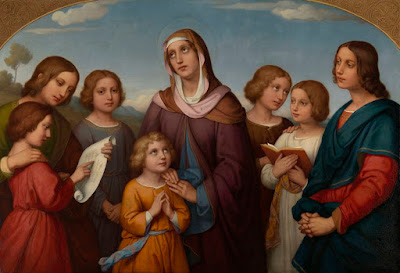We are now within the Octave of Christmas. This is one of only three Octaves retained in the 1962 Missal and one of only two kept in the Novus Ordo. This Octave, like the many in place up until 1955, is worth understanding so we can better enter into its mysteries and continue living and celebrating them throughout the Octave.
The Octave of Christmas is unique since the Feasts of St. Stephen, St. John the Apostle, and the Holy Innocents which are celebrated on the 2nd, 3rd, and 4th days respectively of the Christmas Octave used to be Holy Days of Obligation. The three are sometimes known as the “Comites Christi " (Companions of Christ). An article from a few years ago on liturgical notes for the Octave is worth reading at the New Liturgical Movement.
No sooner do we conclude the office of Christmas Day than we celebrate the feast of the first Martyr. Why is this so? Does the feast of St Stephen just happen to fall on December 26? Why would the Church turn so quickly from the creche to consider the deacon who was stoned to death after Our Lord's Resurrection? And what about the feasts of the following days? What is their connection with Christmas?The first three feasts of the Christmas Octave have been observed since antiquity. They were always devoutly referred to as the Three Companions. We begin with St Stephen, murdered at the direction of Saul of Tarsus, whose conversion we shall celebrate one month later. Stephen was a martyr loquendo et moriendo, by his words and by his death. The next day we return to white vestments, for St John is the only Apostle not celebrated in red. He was the only Apostle who did not abandon his Savior at Calvary, and so God decreed that he should be a martyr loquendo sed non moriendo, by his words but not by his death, for he would be miraculously preserved from his execution and end his life in peace on the island of Patmos. Then on December 28 we celebrate Childermas, the feast of the Holy Innocents, those little ones of Bethlehem who, as we pray in the collect of their Mass, bore witness to Christ non loquendo, sed moriendo, not by their words, but by their deaths, for they were killed by raging Herod on the chance that one of them might be the newborn King.Herods are to be found in every age, for sinful rulers always view the kingdom of Christ as a threat to their earthly power. And so on December 29 we keep the feast of Thomas Becket, the holy bishop of Canterbury who upheld the freedom of the Church from the interference of the state and so was cut down by King Henry II’s men during Christmas Vespers.On December 30 we take up again the Mass and Office of Christmas, like a beautiful refrain, and then remain in white vestments for the conclusion of the Octave. December 31 is the feast of St Sylvester, celebrated in white because he is the first pope who was not a martyr, bringing the age of martyrs to a close with the peace of Constantine.
By the 8th century, Rome had developed liturgical octaves not only for Easter, Pentecost, and Christmas but also for the Epiphany and the feast of the dedication of a church.
After 1568, when Pope Pius V reduced the number of octaves (since by then they had grown considerably), the number of Octaves was still plentiful. Octaves were classified into several types. Easter and Pentecost had "specially privileged" octaves, during which no other feast whatsoever could be celebrated. Christmas, Epiphany, and Corpus Christi had "privileged" octaves, during which certain highly ranked feasts might be celebrated. The octaves of other feasts allowed even more feasts to be celebrated.
To reduce the repetition of the same liturgy for several days, Pope Leo XIII and Pope St. Pius X made further distinctions, classifying octaves into three primary types: privileged octaves, common octaves, and simple octaves. Privileged octaves were arranged in a hierarchy of first, second, and third orders. Christmas was a Privileged Octave of the Second Order along with the Octave of Epiphany. Only the Octaves of Easter and Pentecost ranked higher as Privileged Octaves of the First Order.






























